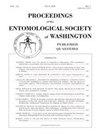Intraspecific Variation in Three Species of Semudobia (Diptera: Cecidomyiidae) Forming Fruit Galls on Betula (Betulaceae) in the Holarctic Region
IF 0.4
4区 农林科学
Q4 ENTOMOLOGY
Proceedings of the Entomological Society of Washington
Pub Date : 2022-12-08
DOI:10.4289/0013-8797.124.3.516
引用次数: 0
Abstract
Abstract. We analyzed the Folmer fragment of the mitochondrial COI gene of three closely related species of Semudobia (Diptera: Cecidomyiidae): S. betulae (Winnertz), S. tarda Roskam, and S. skuhravae Roskam. These species form fruit galls on different birch species (Betula, Betulaceae) in the Holarctic Region. In Japan, larvae of S. betulae and S. tarda were collected from the native Japanese birch, B. platyphylla, whereas S. skuhravae was collected from the eastern Palearctic birch, B. ermanii. In the Netherlands, the three species were collected from intermediate forms between the Eurasian endemic birches, B. pendula and B. pubescens. Additional sequences of Canadian and European S. betulae and S. skuhravae were obtained from the Barcode of Life Data system (BOLD). In a maximum likelihood analysis, the individuals of each species formed strongly supported clades, but genetic divergence was high within each clade indicating species complexes. European and Canadian individuals of S. betulae and S. skuhravae each formed a single clade with low intraspecific variation, suggesting that these species were introduced together with their hosts to North America. In contrast, Japanese individuals of the three Semudobia species were remarkably distant from European and Canadian individuals, indicating that they have been isolated genetically for a long period on their native eastern Palearctic and Japanese hosts.全北极地区桦木(桦木科)上三种拟蝇(双翅目:柞蚕科)形成果瘿的种内变异
摘要我们分析了3个近缘种:S. betulae (Winnertz)、S. tarda Roskam和S. skuhravae Roskam线粒体COI基因的前片段。这些物种在全北极地区不同的桦树物种(桦树,桦树科)上形成果实瘿。在日本,桦树和迟发孢的幼虫采自日本本土桦树白桦(B. platyphylla),而skuhravae采自古北东桦(B. ermanii)。在荷兰,这三个物种是从欧亚特有桦树,B. pendula和B. pubescens之间的中间形态收集的。从生命数据条形码系统(BOLD)中获得加拿大和欧洲桦树和树的附加序列。在最大似然分析中,每个物种的个体形成了强烈支持的分支,但每个分支内部的遗传差异很高,表明物种复杂。欧洲和加拿大的桦树和树的个体形成了一个单一的分支,种内变异很小,表明这些物种与它们的寄主一起被引入北美。相比之下,三种Semudobia的日本个体与欧洲和加拿大个体的距离明显很远,这表明它们在古北东部和日本的本土宿主上已经分离了很长一段时间。
本文章由计算机程序翻译,如有差异,请以英文原文为准。
求助全文
约1分钟内获得全文
求助全文
来源期刊
CiteScore
0.90
自引率
16.70%
发文量
40
审稿时长
>12 weeks
期刊介绍:
The Proceedings of the Entomological Society of Washington is published four times a year in January, April, July, and October. The journal publishes on all aspects of original research in entomology. Subject matter includes systematics, taxonomy, biology, behavior, ecology, morphology, genetics, and other topics.

 求助内容:
求助内容: 应助结果提醒方式:
应助结果提醒方式:


